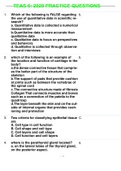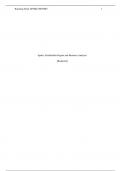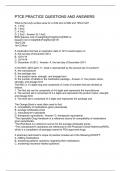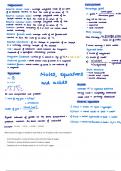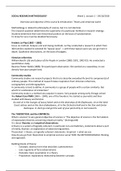Last Edited: 13/2/2019
Patapee Lohprasert ()
Mechanical Engineering Department, Imperial College London
, Table of Contents
1 Gravitational Fields and Electric Fields .......................................................................................... 1
2 Magnetic Fields ............................................................................................................................... 2
3 Circular Motion ................................................................................................................................ 4
4 Oscillations ....................................................................................................................................... 5
5 Thermal Physics ............................................................................................................................... 6
6 Transformer .................................................................................................................................... 10
7 Capacitors ...................................................................................................................................... 11
8 Electronics & Communication ..................................................................................................... 12
9 OP-AMPS........................................................................................................................................ 15
10 Quantum Physics ......................................................................................................................... 16
10.1 Nuclear Physics ........................................................................................................................... 16
10.2 Ultrasound .................................................................................................................................. 17
10.3 Photoelectric Effect..................................................................................................................... 18
10.4 Band Theory ................................................................................................................................ 20
10.5 Radioactivity ............................................................................................................................... 21
10.5 X-ray ............................................................................................................................................ 22
,1 Gravitational Fields and Electric Fields
1.1 Important Definitions
Field of force: region (of space) where a force is experienced by a particle
Gravitational Field: region of space where a mass experiences a force
Gravitational Field Strength: Force per unit mass
Electric field strength: force per unit positive charge acting on a stationary charge
Gravitational potential: work done in bringing unit mass from infinity to the point
Electric potential: work done/ energy in moving unit positive charge from infinity to the
point
Newton’s law of gravitation: force proportional to product of the two point masses and
inversely proportional to the square of their separation
Coulomb’s Law: force proportional to product of charges and inversely proportional to
square of separation
1.2 Key Equations
Gravitational Field:
𝐺𝑚1 𝑚2
1. 𝐹= (Gravitational Force 𝐹 , 𝐺 = 6.67 × 10−11 )
𝑟2
𝐺𝑚
2. 𝜙 = − (Gravitational Potential 𝜙)
𝑟
Electric Field:
𝑞1 𝑞2
1. 𝐹 = (Electrical Force 𝐹, 𝜖0 = 8.85 × 10−12 )
4𝜋𝜖0 𝑟 2
𝑉
2. 𝐸 = (Electric Field Intensity 𝐸, distance of two charged
𝑑
plates, 𝑑)
𝑄
3. 𝑉 = (Electric Potential 𝑉)
4𝜋𝜖0 𝑟
1.3 Exam Style Questions and Key Points
State what is meant by a line of force in
• A gravitational field: tangent to line gives direction of force on a small test mass
• An electric field: tangent to line gives direction of force on a small positive test
charge
Similarities and differences between gravitational force field and electric force field
around a charged metal sphere isolated in space.
• Similarities:
, • radial fields
• lines normal to surface
• greater separation of lines with increased distance from sphere
1
• field strength ∝
(𝑑𝑖𝑠𝑡𝑎𝑛𝑐𝑒 𝑡𝑜 𝑐𝑒𝑛𝑡𝑟𝑒 𝑜𝑓 𝑠𝑝ℎ𝑒𝑟𝑒)²
• Differences:
• gravitational force (always) towards sphere
• electric force direction depends on sign of charge on sphere (towards or away
from sphere)
Why gravitational potential is a negative quantity:
• Gravitational potential at infinity is zero
• Gravitational force attractive so work done as object moves from infinity so potential
is negative
• OR, gravitational force is (always) attractive
• work is done is by masses so negative as they come together
Why the electric field strength in metal sphere is zero
• charges in metal do not move
𝐹
• no (resultant) force on charges so no (electric) field (as 𝐸 = )
𝑄
Why points outside an isolated spherical conductor, the charge on the sphere may be
considered to act as a point charge at its centre:
• lines perpendicular to surface OR, lines are radial
• lines appear to come from center
2 Magnetic Fields
2.1 Important Definitions
Tesla: uniform magnetic flux normal to long straight wire carrying a current of 1A creates
force per unit length of 1 Nm^-1
Faraday’s law: Induced e.m.f is directly proportional to the rate of change of magnetic flux
∆𝑁𝛷
linkage. (𝑉 = )
∆𝑡
Lenz’s law: induced e.m.f./current produces effects in a direction that opposes the change
causing it
Quantisation of charge: charge exists in discrete and equal quantities
1.2 Key Equations
1. 𝐹 = 𝐵𝐼𝐿 (Magnetic Force 𝐹, Magnetic Field Strength 𝐵, length 𝐿)
, 2. Ф = BA (Magnetic flux Ф, Area 𝐴 perpendicular to 𝐵)
3. Flux linkage = ФN (𝑁 = number of turns)
2.3 Exam Style Questions and Key Points
Magnetic field of Earth is always horizontal unless at the poles.
Why a Hall probe is made from a thin slice of material
• Hall voltage depends on thickness of slice
• thinner slice, larger Hall voltage
Why is it difficult to detect hall voltage in a thin slice of copper:
• (in metal,) n is very large
• (therefore) hall voltage is small
Value of the Hall Voltage:
• Hall voltage depends on angle between field and plane of probe
• Max when field normal to plane of probe
Explain why the r.m.s value of the current in the solenoid is reduced as a result of inserting
an iron core:
• For same current iron core gives larger rate of change of flux linkage (iron core
increase the magnetic field strength -> increases flux density)
• e.m.f induced in solenoid is greater (for same current)
• induced e.m.f. opposes applied e.m.f. so current smaller/acts to reduce current
As the magnet is being moved into the solenoid, thermal energy is transferred in the
resistor. Use laws of electromagnetic induction to explain this thermal energy:
• moving magnet gives rise to/causes/induces e.m.f./current in solenoid/coil
• (induced current) creates field/flux in solenoid that opposes (motion of) magnet
• work is done/energy is needed to move magnet (into solenoid)
• (induced) current gives heating effect (in resistor) which comes from the work done
Two wires are laid side-by-side and carry equal currents I in opposite directions, explain
why the total magnetic flux density due to the current in the wires is negligible:
• magnetic fields are equal in magnitude/strength/flux density
• magnetic fields are opposite in direction
• fields superpose/add/cancel to give zero/negligible resultant field
Why magnet falling down through Aluminum takes longer to fall than and plastic tube :
• as magnet falls, tube there is a change in magnetic flux
, • (different rate of change of magnetic flux at different part of tube so there is p.d and)
eddy current induced in aluminum tube but current can’t flow in plastic tube
• eddy current causes heating effect
• heat energy derived from KE of falling magnet
• terminal velocity decreases so longer time in aluminum
Reduction in amplitude of oscillation when a metal block cuts a magnetic field:
• metal block cut magnetic flux at different rate so different induced emf at different
part
• give rise to eddy current which causes heating effect
• heat energy derived from energy of oscillation
3 Circular Motion
3.1 Important Definitions
Radian: angle subtended from centre of a circle where arc length is equal to the radius
3.2 Key Equations:
2𝜋
1. 𝜔 = = 2𝜋𝑓 (Angular Frequency 𝜔)
𝑡
2. 𝑣 = 𝜔𝑟
3. 𝐹 = 𝑚𝜔2 𝑟 (Centripetal Force 𝐹)
4. 𝑎 = 𝜔2 𝑟 (Centripetal Acceleration 𝑎)
3.3 Exam Style Questions and Key Points
Path of the electron in the magnetic field is in the arc of a circle
• (magnetic) force (always) normal to velocity/direction of motion
• (magnitude of magnetic) force constant // speed is constant / kinetic energy is
constant
• magnetic force provides/is the centripetal force
• OR :
• Force due to magnetic field is constant
• Speed of particle is constant
• Force always normal to direction of motion
• Magnetic force provides centripetal force
Speed of particle in arc is not affected by magnetic field :
• Magnetic field always perpendicular to direction of motion
• so there is no work done on the particle



